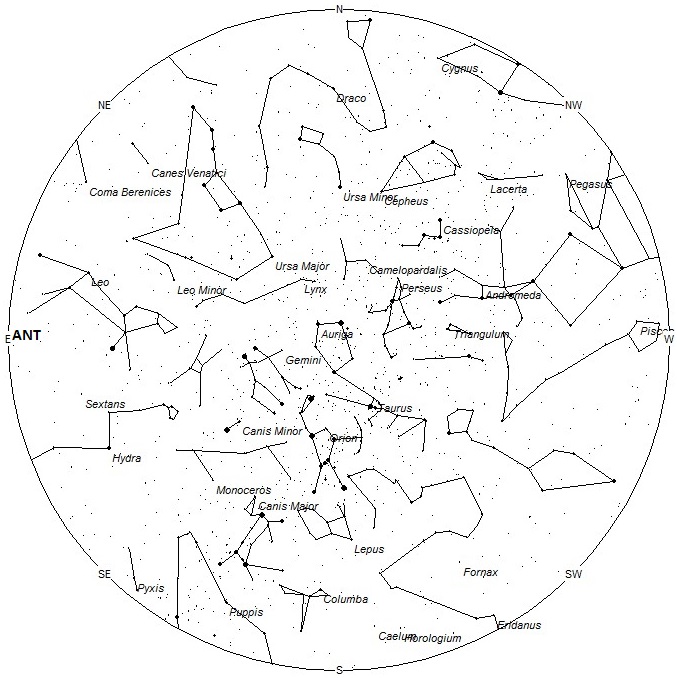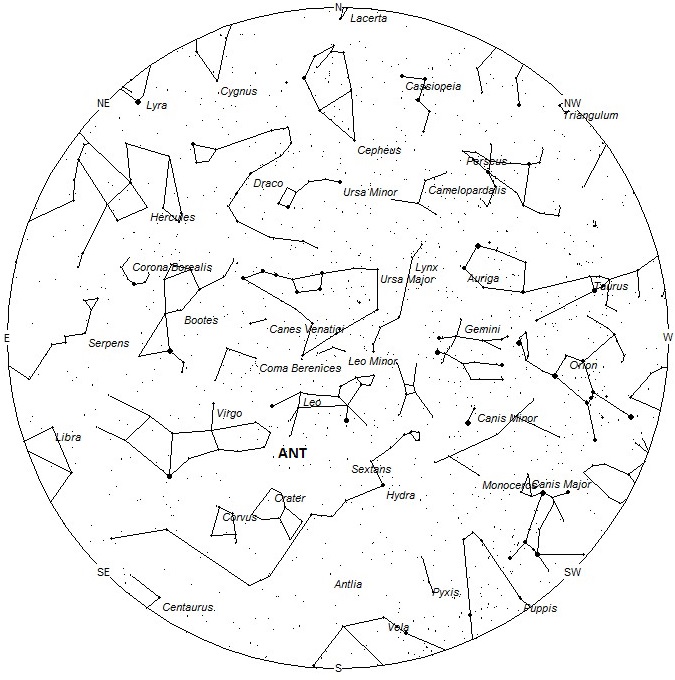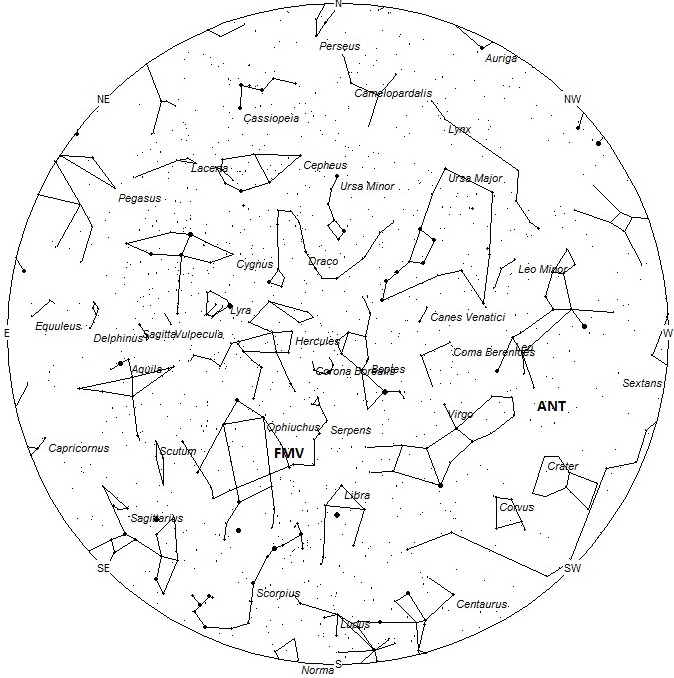
Dec. 13th 2017 (Canon EOS 6D – EF16-35mm f/4L IS USM, ƒ/4.0, 20s, 17.0 mm, ISO 3200) © Lukas Schlagenhauf
During this period the moon will reach its full phase on Thursday March 1st. At that time the moon will lie opposite the sun and will lie above the horizon all night long. This weekend the waxing gibbous moon will set shortly after midnight allowing the meteor observer to view under dark conditions the remainder of the night. This window of opportunity will shorten by about an hour with each passing night until the moon lies above the horizon all night long later in the week. The estimated total hourly meteor rates for evening observers this week is 3 as seen from mid-northern latitude (45N) and 5 from the southern tropics (25S). For morning observers the estimated total hourly rates should be near 8 as seen from mid-northern latitudes (45N) and 13 from the southern tropics (25S). The actual rates will also depend on factors such as personal light and motion perception, local weather conditions, alertness and experience in watching meteor activity. Evening rates are reduced by moonlight during this period. Note that the hourly rates listed below are estimates as viewed from dark sky sites away from urban light sources. Observers viewing from urban areas will see less activity as only the brighter meteors will be visible from such locations.
The radiant (the area of the sky where meteors appear to shoot from) positions and rates listed below are exact for Saturday night/Sunday morning February 24/25. These positions do not change greatly day to day so the listed coordinates may be used during this entire period. Most star atlases (available at science stores and planetariums) will provide maps with grid lines of the celestial coordinates so that you may find out exactly where these positions are located in the sky. A planisphere or computer planetarium program is also useful in showing the sky at any time of night on any date of the year. Activity from each radiant is best seen when it is positioned highest in the sky, either due north or south along the meridian, depending on your latitude. It must be remembered that meteor activity is rarely seen at the radiant position. Rather they shoot outwards from the radiant so it is best to center your field of view so that the radiant lies near the edge and not the center. Viewing there will allow you to easily trace the path of each meteor back to the radiant (if it is a shower member) or in another direction if it is a sporadic. Meteor activity is not seen from radiants that are located far below the horizon. The positions below are listed in a west to east manner in order of right ascension (celestial longitude). The positions listed first are located further west therefore are accessible earlier in the night while those listed further down the list rise later in the night.
These sources of meteoric activity are expected to be active this week.
.
The center of the large Anthelion (ANT) radiant is currently located at 11:16 (169) +04. This position lies in southeastern Leo, 2 degrees southwest of the 4th magnitude star known as sigma Leonis. Due to the large size of this radiant, Anthelion activity may also appear from western Virgo, and Sextans as well as Leo. This radiant is best placed near 0100 local standard time (LST), when it lies on the meridian and is located highest in the sky. Rates at this time should be near 2 per hour no matter your location. With an entry velocity of 30 km/sec., the average Anthelion meteor would be of slow velocity.
The February Mu Virginids (FMV) were discovered by Damir Šegon and the Croatian Meteor Network team based on studying SonotaCo and CMN observations (SonotaCo 2007-2011, CMN 2007-2010). These meteors are active from February 16 through March 4 with maximum activity occurring on February 25. The current radiant position lies near 16:24 (246) -02, which actually places it on the border of Ophiuchus and Sepens Caput, 3 degrees northeast of the pair of stars known as “Yeds” (epsilon and delta Ophiuchi). Rates are expected to be less than 1 per hour no matter your location. These meteors are best seen near 0500 LST when the radiant lies highest above the horizon. At 62 km/sec. the February Mu Virginids would produce mostly swift meteors.
As seen from the mid-northern hemisphere (45N) one would expect to see approximately 6 sporadic meteors per hour during the last hour before dawn as seen from rural observing sites. Evening rates would be near 2 per hour. As seen from the tropical southern latitudes (25S), morning rates would be near 11 per hour as seen from rural observing sites and 3 per hour during the evening hours. Evening rates are reduced due to moonlight. Locations between these two extremes would see activity between the listed figures.
| SHOWER | DATE OF MAXIMUM ACTIVITY | CELESTIAL POSITION | ENTRY VELOCITY | CULMINATION | HOURLY RATE | CLASS |
| RA (RA in Deg.) DEC | Km/Sec | Local Standard Time | North-South | |||
| Anthelion (ANT) | – | 11:16 (169) +04 | 30 | 01:00 | 2 – 2 | II |
| February mu Virginids (FMV) | Feb 25 | 16:24 (246) -02 | 62 | 07:00 | <1 – <1 | IV |
 American Meteor Society
American Meteor Society



I’m in Lexington, SC and just seen.a single shooting star separating into two. Amazing. Absolutely astonishing to witness.
Last Sunday I saw the same thing in my place, Jakarta
Saw it in Seattle at 1am on Saturday February 24. The most beautiful thing I’ve ever seen. The whole sky was green for a quick second
We saw an amazing spectacle in Iowa around 8:45 PM on the 28th of February 2018. The sky was glowing green with a bright streak of green that changed to orange and then vanished! It was amazing, my teenager was speechless!
February 28, 2018 my daughter and I saw it at about 9pm in West Allis, WI
Was what you saw high in the sky?
Just saw a meteorite sitting outside my hotel room in Kalispell Montana at 7:07 pm. I could not help but see it! Fireball from mid sky going North rite side of full moon. always amazing to witness something like this. I always try to see falling stars but this is different. looked like it hit in Columbia falls! Where does it really end up is my question?!
Laura and All,
While some meteors appear to reach the horizon and hit the ground a very small percentage actually do so. 99.99% of meteors completely disintegrate while still high in the atmosphere. The key to having them reach the ground is to be larger than the average pebble-size meteor and to survive down to the lower atmosphere. If they do so they will produce a sonic boom as they are still traveling faster than the speed of sound. So any events that are accompanied by sound may have produced meteorites on the ground.
I hope this helps!
Robert Lunsford
On Feb 28 at about 9 PM we were driving west on Hwy 20 in Racine county just west of Ives Grove and it seemed like about 1/4 mile in front of our car came this flash of light greenish blueish flame. in the front of it seemed to have corners or points that were illuminated. it had a tail of color approx. 5 feet long. It went across the road and seemed to go into the plowed farm field to the south of us. We didn’t actually see it hit the ground but it disappeared close to the ground. I have never seen anything like this. I know there were other sightings that night but this one wasn’t high in the sky. We were just amazed when we saw this. .
We saw it looking W SW from Middleton WI (right next to Madison) – about 8:45 PM, saw it low in the sky ~ 10 degrees above the horizon for about 3-4 seconds (through blinds and through trees). It was clearly an orange color and was definitely larger and brighter than Venus – 10X larger, many times brighter. Very cool.